Chaos, conflict and in-fighting best describe Barcelona’s tumultuous offseason.
After dropping La Liga to Real Madrid, then suffering an 8-2 humiliation at the hands of the UEFA Champions League winners, Bayern Munich, a return to the pitch is exactly what the club needs as they open up the season against a Villarreal side with high expectations.
Villarreal’s comes into this one with two games already in the books. A season-opening draw against newly-promoted Huesca and narrow win over Eibar look disappointing on the surface, but Villarreal’s dominance and the quality of the chances they created will give them hope against a wounded Barcelona side.
In this tactical analysis, we’ll look at Villarreal’s attacking rotations and adaptations in Barca’s new-look attack. Analysis of defensive vulnerabilities will also shed light on the possible tactical points each team will address.
Predicted lineups
Barcelona predicted lineup (4-2-3-1): Neto, Sergi Roberto, Clément Lenglet, Gerard Piqué, Jordi Alba; Sergio Busquets, Frenkie de Jong; Lionel Messi, Philippe Coutinho, Ansu Fati; Antoine Griezmann
Ronald Koeman makes his debut on the Barcelona bench with a formation and side that should mirror the one that recently faced Elche. With Marc-André ter Stegen still recovering from an injury, Neto gets the start in goal. The backline features Roberto, Lenglet, Piqué and Alba, while Busquets and de Jong form a double pivot. Miralem Pjanić is expected to make his debut at some point in this match as part of the pivot. Griezmann will nominally lead the line with Messi, Coutinho and Fati underneath. Ousmane Dembélé and Francisco Trincão could also receive starts in this match but are more likely to start on the bench.
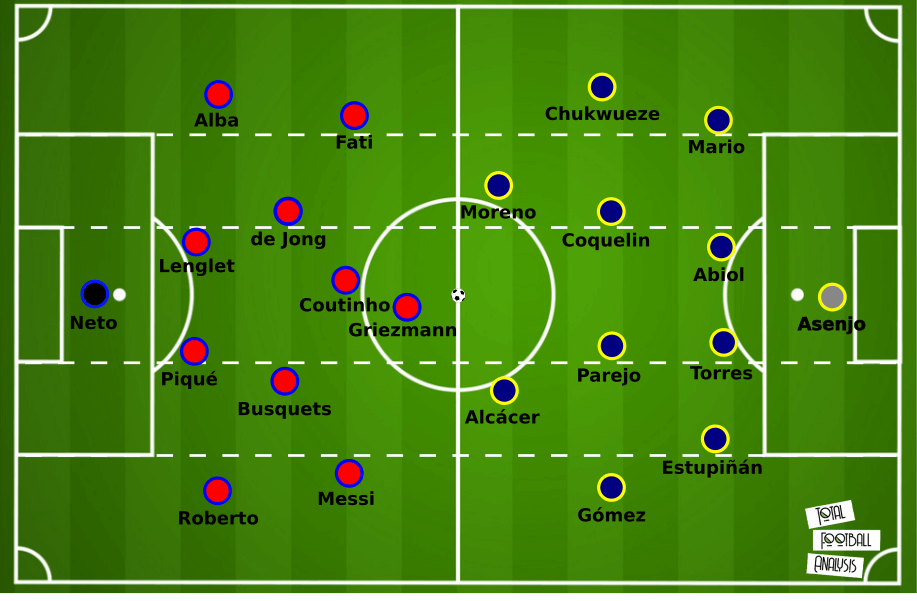
Villarreal predicted lineup (4-4-2): Sergio Asenjo, Mario Gaspar, Raúl Albiol, Pau Torres, Pervis Estupiñán; Samuel Chukwueze, Vicente Iborra (Parejo), Dani Parejo (Francis Coquelin), Moi Gómez; Gerard Moreno, Paco Alcácer
Look for Unai Emery field a similar roster the previous matches. Within the 4-4-2, Asenjo will be in goal with a backline of Marion, Abiol, Torres and Estupiñán. In midfield, Chukwueze and Gómez should get the starts on the wings with Coquelin and Parejo in the middle. Up top, expect the pairing of Moreno and Alcácer. All signs point to Real Madrid’s Takefusa Kubo not making earning his first start of the season.
Villarreal’s attacking rotations
Last campaign, Villarreal’s potent attack was the key to securing Europa League play. At the heart of their attack was an array of intricate positional rotations. If the first two matches of the season offer any indication of Emery’s approach, it’s that the heavy rotations will continue.
While the specific rotations will depend heavily on where Villarreal has regained possession, there are a few basic principles. In the middle and attacking thirds, look for one player to provide width in either wing and half space runs to get behind the line and offer a better point of service.
Rotations when building out of the back and connecting the lines are more intricate. The sequence of images below will offer a look at one of the most commonly used patterns Villarreal use. It all starts with the Asenjo, the backline and two central midfielders in a 1-2-4. Asenjo is always the deep option while the centre-backs play as the point men in the attack. Meanwhile, the outside-backs push up into line with the centre mids.
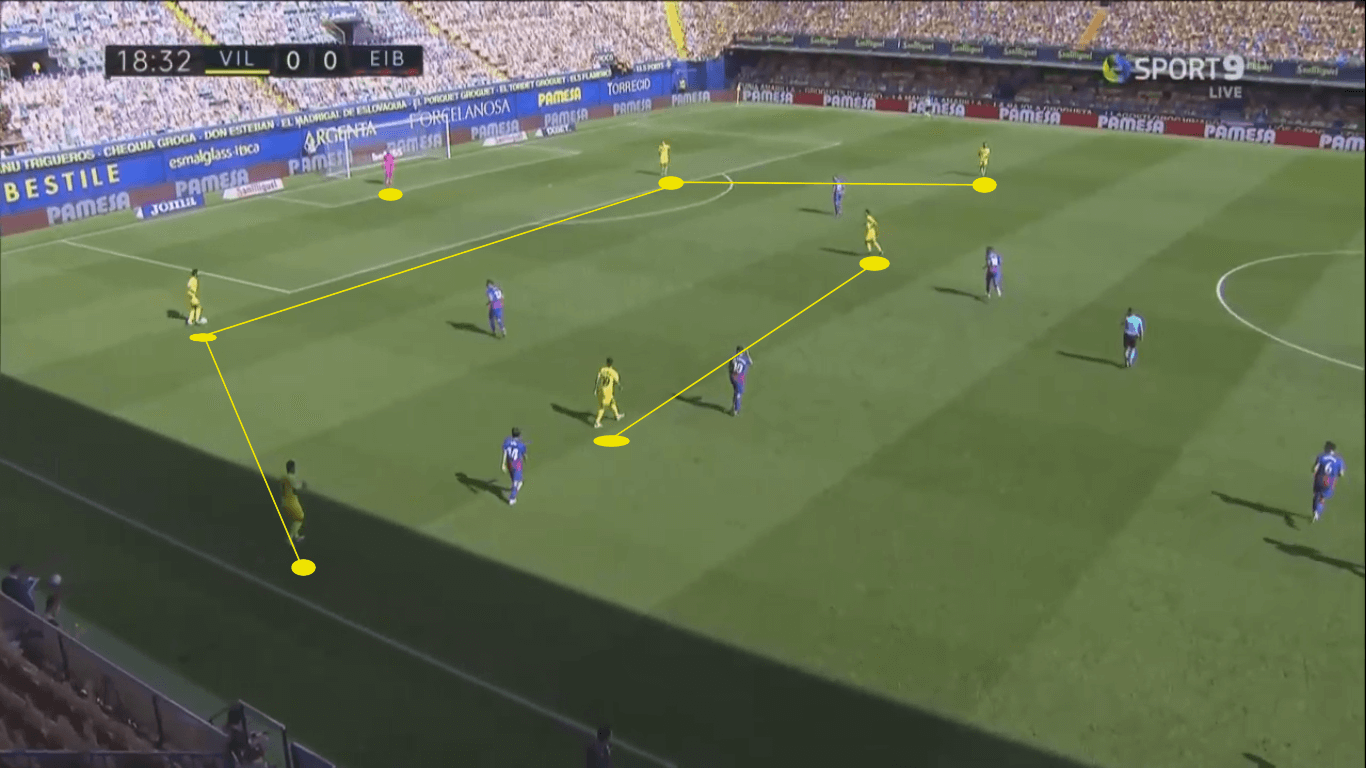
Looking at the rest of the image, you get the sense that the lines are too disconnected. Here we can’t even see the wide midfielders or the forwards in what’s roughly an 18-metre gap. That encourages the five Eibar players to push forward and engage in a high press.
As the opponent becomes unbalanced, you’ll see Gómez and Moreno fill in the space between the lines. Parejo dropping deeper cues Gómez to move into the left half space, in line with Coquelin. Meanwhile, Moreno is free to interpret the available space and drop accordingly.
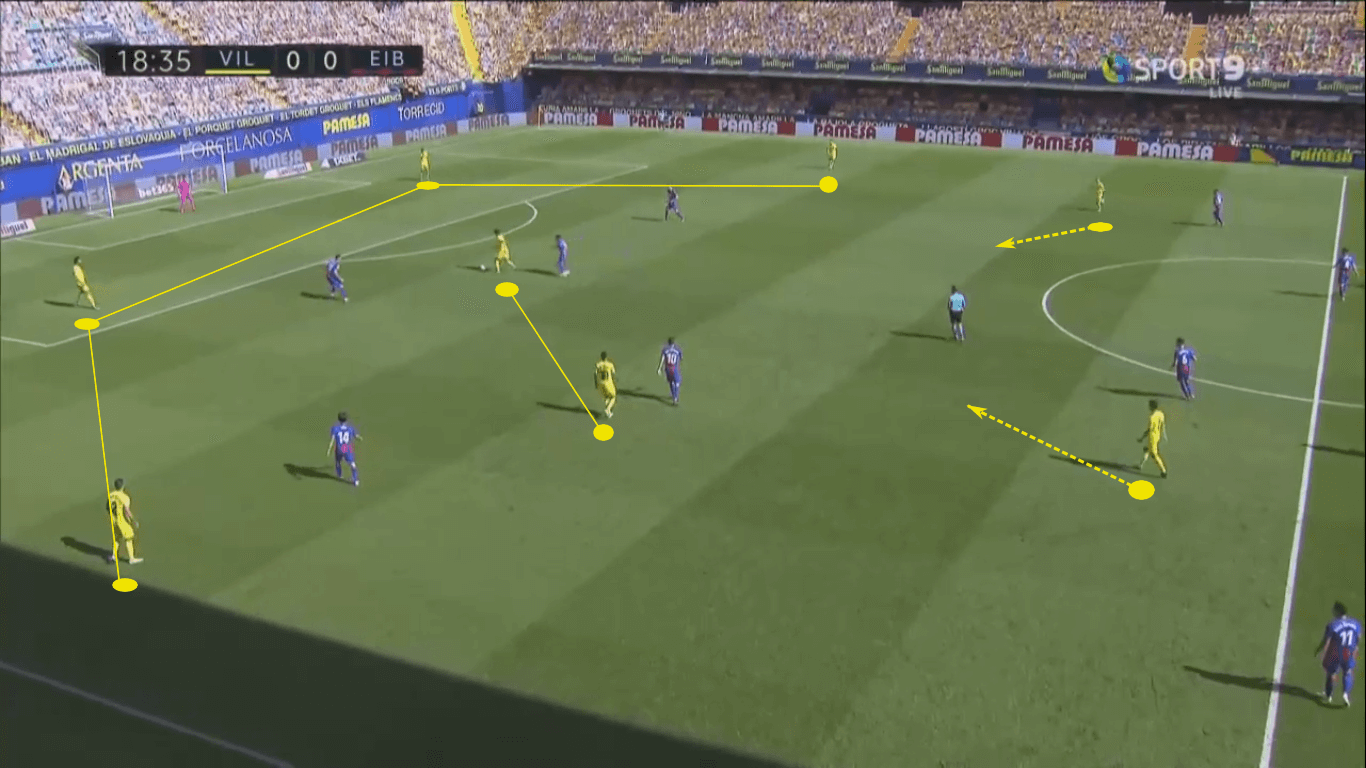
The outside-backs stay a little deeper until the side can safely secure progression and the new three-man midfield forms a V, which offers Parejo the protection he lacked last season at Valencia. With Gómez and Coquelin joining Parejo to overload the centre of the pitch, Eibar’s line step forward, creating more space for Moreno between the lines.
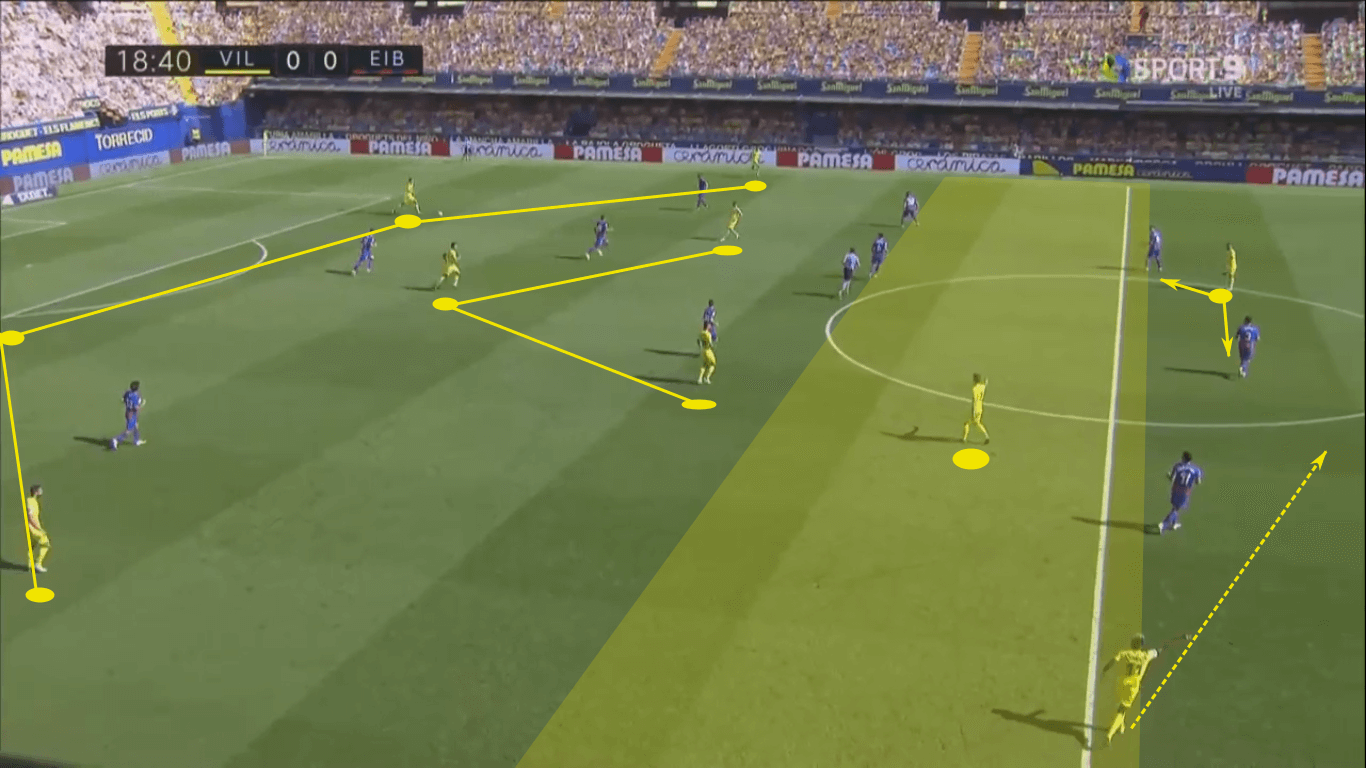
Another factor in creating space for Moreno is the positioning of Alcácer and Chukwueze. Alcácer effectively pins the two centre-backs in the central channel while Chukwueze’s pace keeps the outside-back from moving closer to Moreno. As Moreno drops, Chukwueze looks to unleash his pace behind the lines, cutting inside into the space Moreno vacated.
Even if Chukwueze isn’t played over the top or through, his run to the inside moves the outside-back into the central corridor. The image below shows Moreno receiving the pass while Mario marauding run forward.
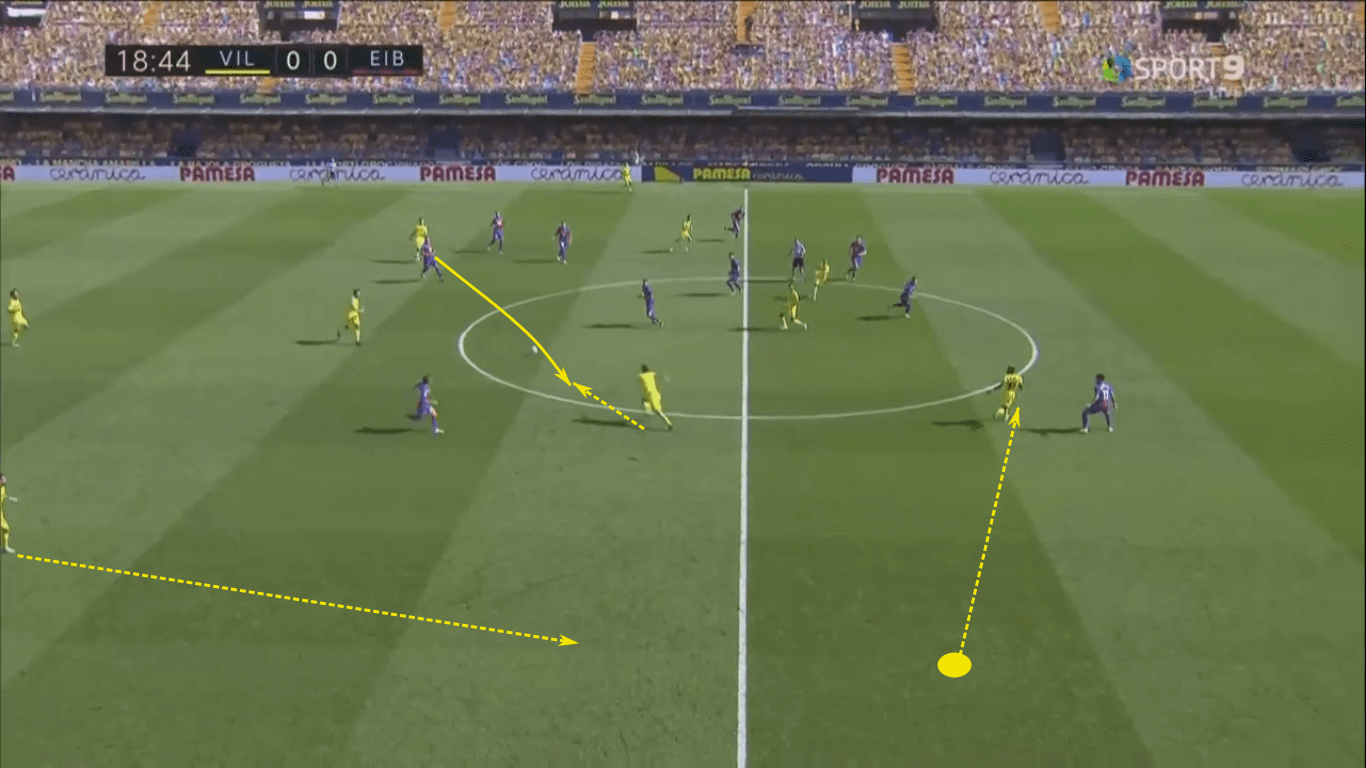
With Chukwueze clearing the wing, Moreno’s pass to Mario uncontested, as is space on the wings. Notice the 20 metres width of the Eibar defence. With the side as narrow as it is, progression through the wing allow Villarreal to easily enter the final third.
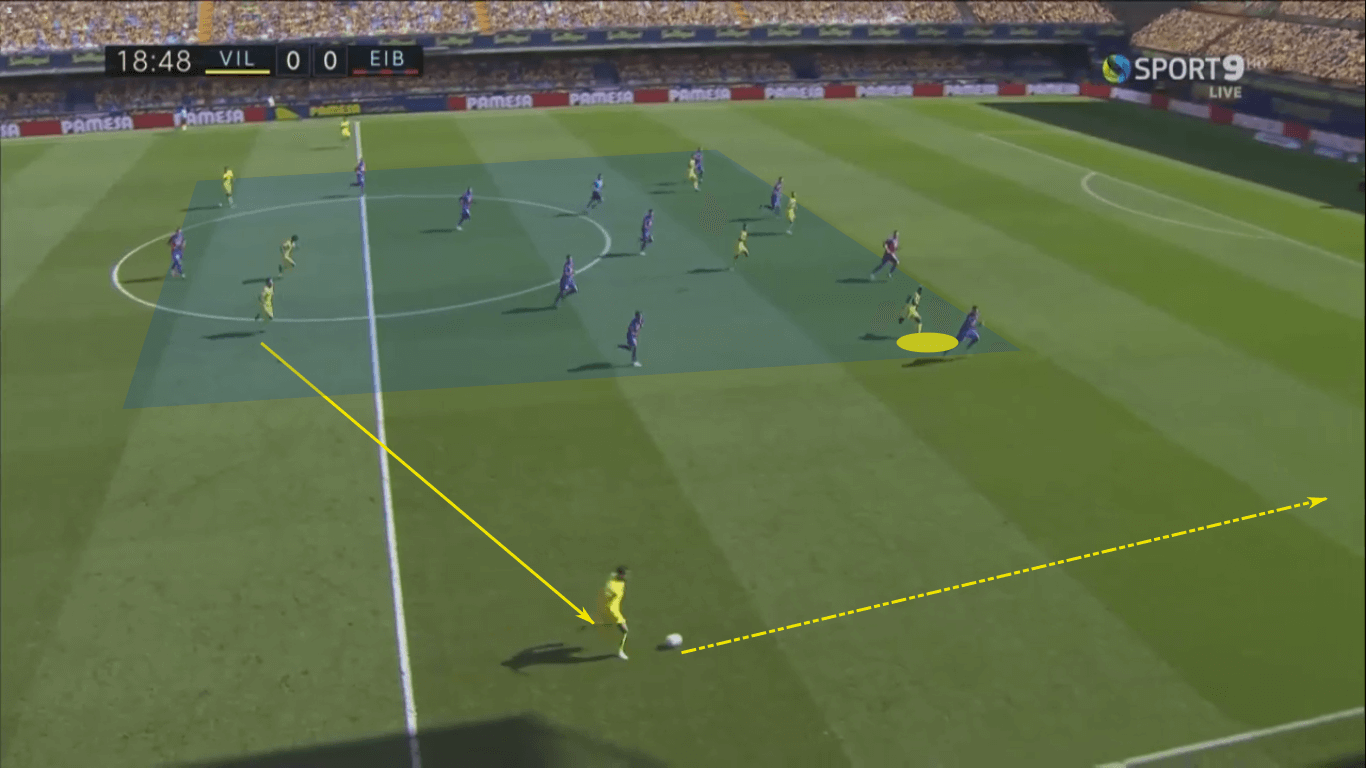
To put the rotation into a single image, Parejo will drop deep, nearly between the centre-backs. That cues Gómez to drop and slide into the left half space, forming a three-man midfield. Moreno will then drop between the lines, cueing Chukwueze to run behind the lines and the outside-backs to provide width higher up the pitch.
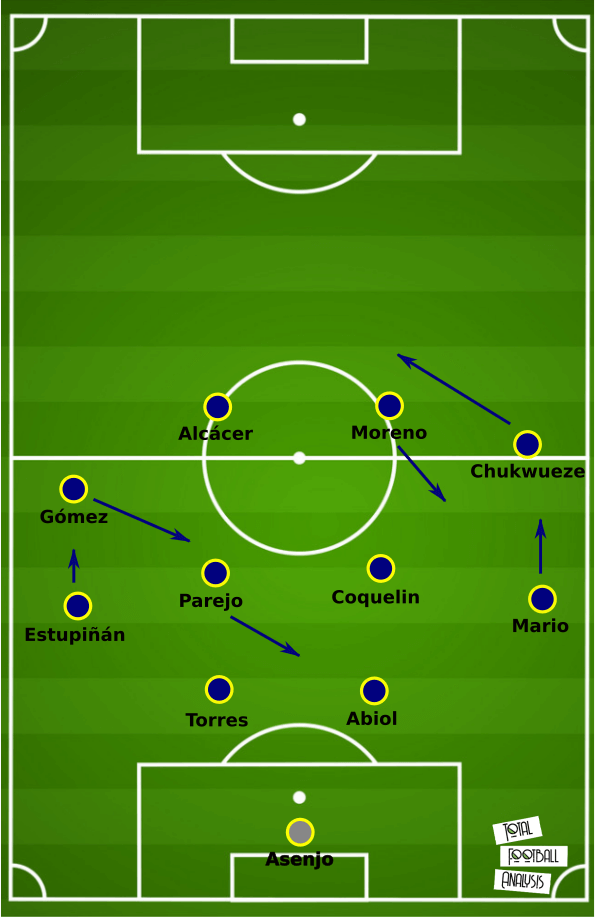
Again, Villarreal has other rotations which are based on their concept of positional play. So long as those specific positions are filled, there is a great deal of fluidity in the system.
Breaking Barcelona’s high press will be key in this match. If Villarreal can find some joy against it, they stand a chance at breaking down this Barcelona backline. Moreno’s movement behind de Jong will especially be key. If de Jong gets caught too high up the pitch, Villarreal will seek out their leading goal-scorer from the previous campaign. With Koeman likely to bring an element of pragmatism to the side, disconnecting de Jong and Busquets will likely be a difficult task, but it offers the best chance of success in attack.
Barcelona’s new-look attack
When Quique Setién was installed as the new Barcelona coach, there was hope that he would return the club to the principles of Guardiola’s prolific attacking football. While the possession stats were comparable, the side failed the address many of the issues encountered at the end of Pep’s reign. Low blocks suffocated the attack, diminishing the space for Barcelona to run into. Arturo Vidal and Luis Suárez were the two players who enjoyed some success against the low block, offering some degree of aerial ability, but, more often than not, attacks were bogged down under the weight of a ten-man low block.
Much like last season, we saw some of this narrowness in attack in the friendly against Girona. As Barcelona look to infiltrate the box, they engaged in a 4v5 at the top of the box. Though they nearly broke through the ranks, Girona’s narrow structure was able to adapt and withstand the pressure.
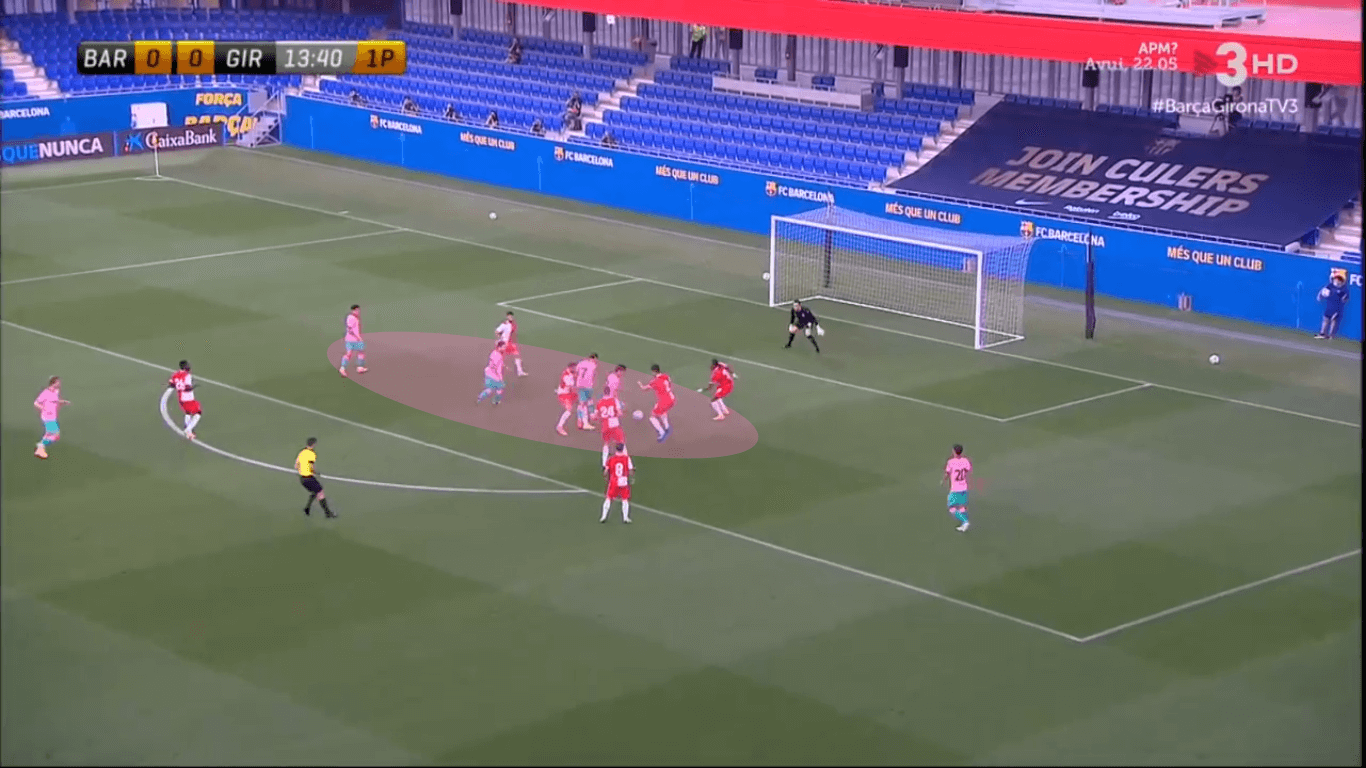
Watching the early friendlies under Koeman, Barcelona looks like they will spend less time pinging the ball from wing-to-wing in the attacking third and more time trying to lure the opponent into the middle third. If Barcelona can do that, they’ll create the space they want to attack. The outside-backs will still be the primary players offering width, leaving the central channel and innermost regions of the half spaces for the central overload.
In the image below, Messi dropped in line with Busquets and de Jong while Griezmann and Coutinho played between the lines. Trincão held a high starting point, pulling the centre-back out of the line, creating space for Alba to run into.
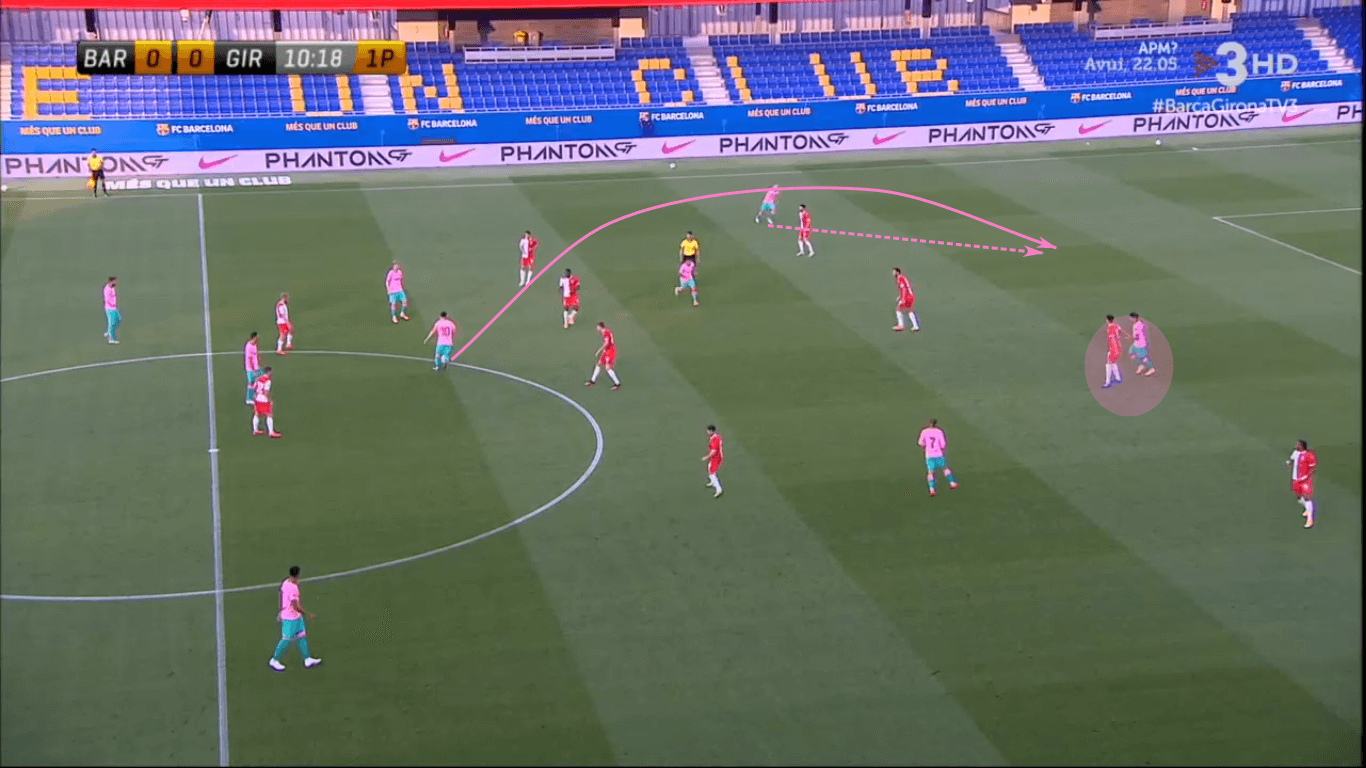
That sequence screams of Golden Era Barcelona with David Villá and Pedro running behind the lines. Since this side is poorly suited to play against the low block, expect to see more of this. Further, Villarreal will likely oblige and press higher up the pitch. Parejo’s defensive work will be critical in this match. If he ventures high or turns off mentally, Barcelona will exploit his defensive weakness.
With Barcelona spending more time in the middle third of the pitch, they’re also encouraging the opponent to risk additional numbers higher up the pitch in search of a recovery. Even if the ball is lost, Barcelona’s central overload leaves them well-positioned to quickly recover the ball before the opponent can play out of pressure. If opponents fly up the pitch immediately after the turnover, Barcelona is then in a position to counterpress and counter-attack.
We all saw the fantastic no-look pass from Messi to Trincão during the Eibar game. That pass set up Coutinho’s opening goal. When you slow the play down, the amount of space Barca is running into is quite shocking. When Busquets offloads to Griezmann, the Frenchman’s touch towards goal draws the defender, giving Messi some separation. Notice Trincão starting his run.
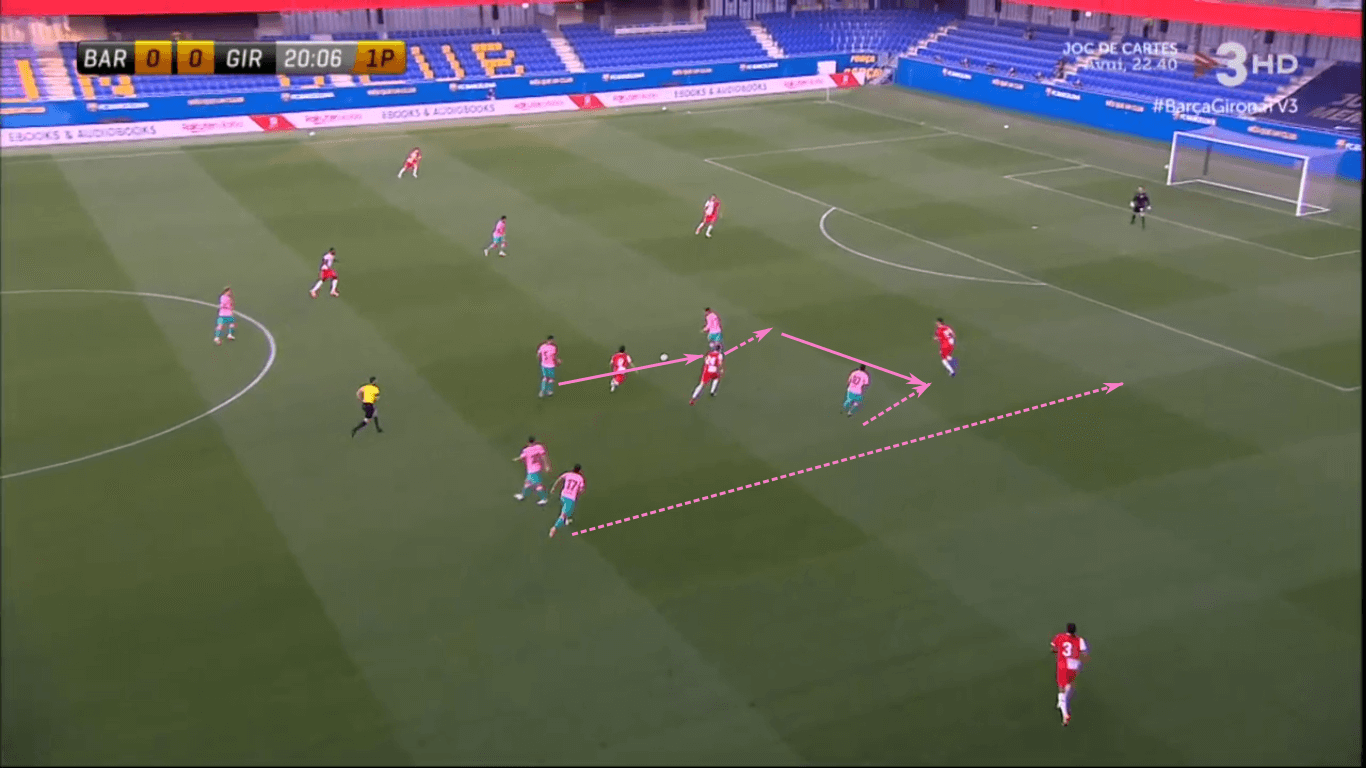
With the defender forced to move from inside-out to defend Messi, the Argentine, as is becoming signature, cut inside, freeing up the half space for Trincão. It’s difficult to capture the exact moment Messi sees Trincão, but this is close to it. You can just barely catch Messi pick out the young Portuguese with his peripheral vision, which is all the more impressive since Messi hardly turns his head. That said, he somehow sees Trincão is sprinting forward on the overlap.
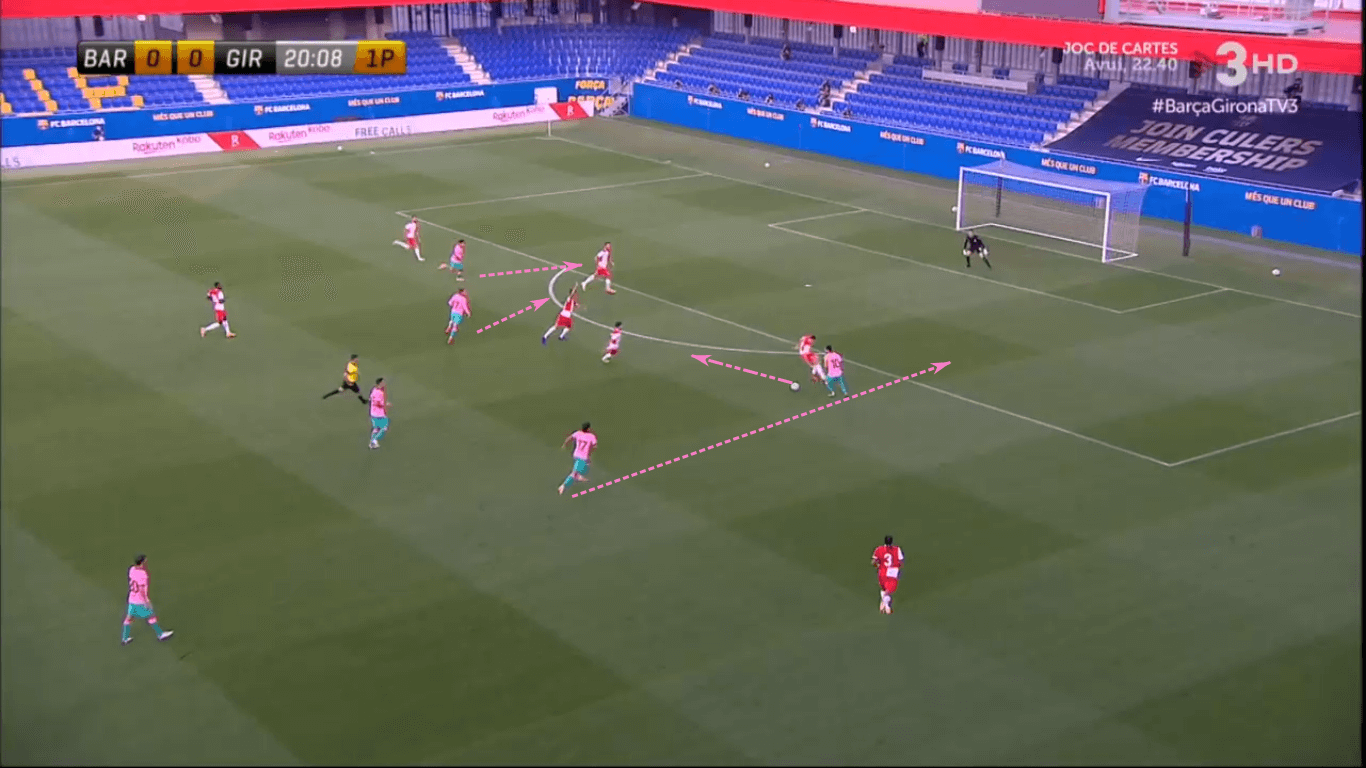
Trincão’s willingness to run behind the lines, paired with Messi’s incredible vision and technical execution, gives the young Portuguese a simple square pass to Coutinho, whose third man run was untracked as Girona scrambled to defend against Messi and Trincão.
If Villarreal are as open in this match as they were in the previous game, these tactics could help Barcelona break this game wide open. You have to assume Villarreal will correct the approach, especially with Emery being a neutral observer to the last matchup, but Villarreal is a bold, at times reckless, team. If they willingly push into the middle third to press Barcelona, then over-commit in attack immediately upon recovery, they run the risk of another blowout. This is the most important factor in the matchup, one Emery and Koeman will thoroughly train in the build-up to the match.
Defensive vulnerabilities
Last season, a recurring theme for each team was defensive vulnerability. In two La Liga matches, Villarreal has managed to hold the opposition to a goal per game while Barcelona has allowed just two goals in three friendlies. That said, the level of competition in those games is far lower than what each team will see this Sunday.
One of the keys for Barcelona is not getting too stretch in the attack before they’ve secured possession and have a great chance of progression. In the friendly against Girona, we saw them take up expansive positions early in possession. Girona were able to catch them out a few times, including in the sequence below. As the throw-in was played to de Jong, he was immediately pressured and mishit a pass, sending it directly to the Girona player in the central channel. With no one available to immediately deny space, he was able to carry the ball to the edge of the box.
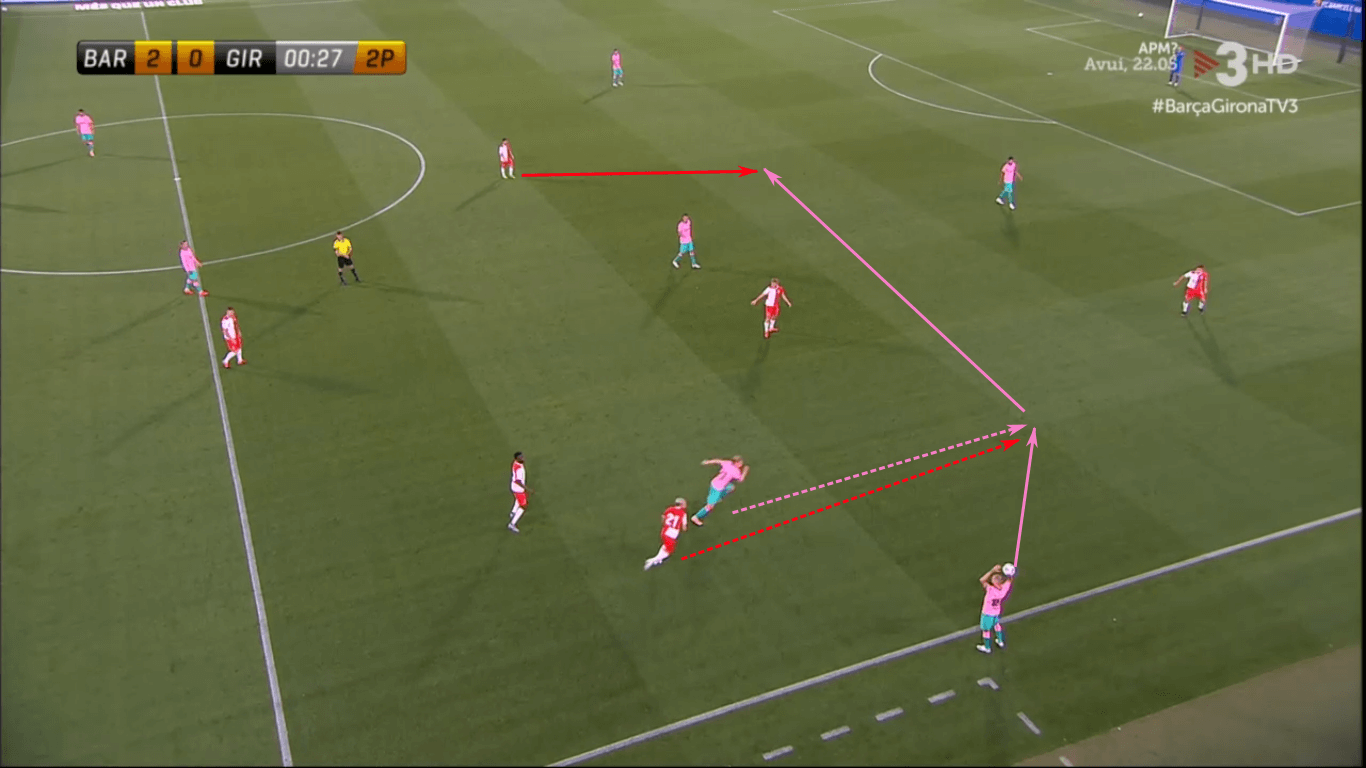
With just Piqué to beat and two runners to his right, Jairo dribbled left to clear a running lane for Samuel Sáiz to run behind the big Spaniard and collect his goal.
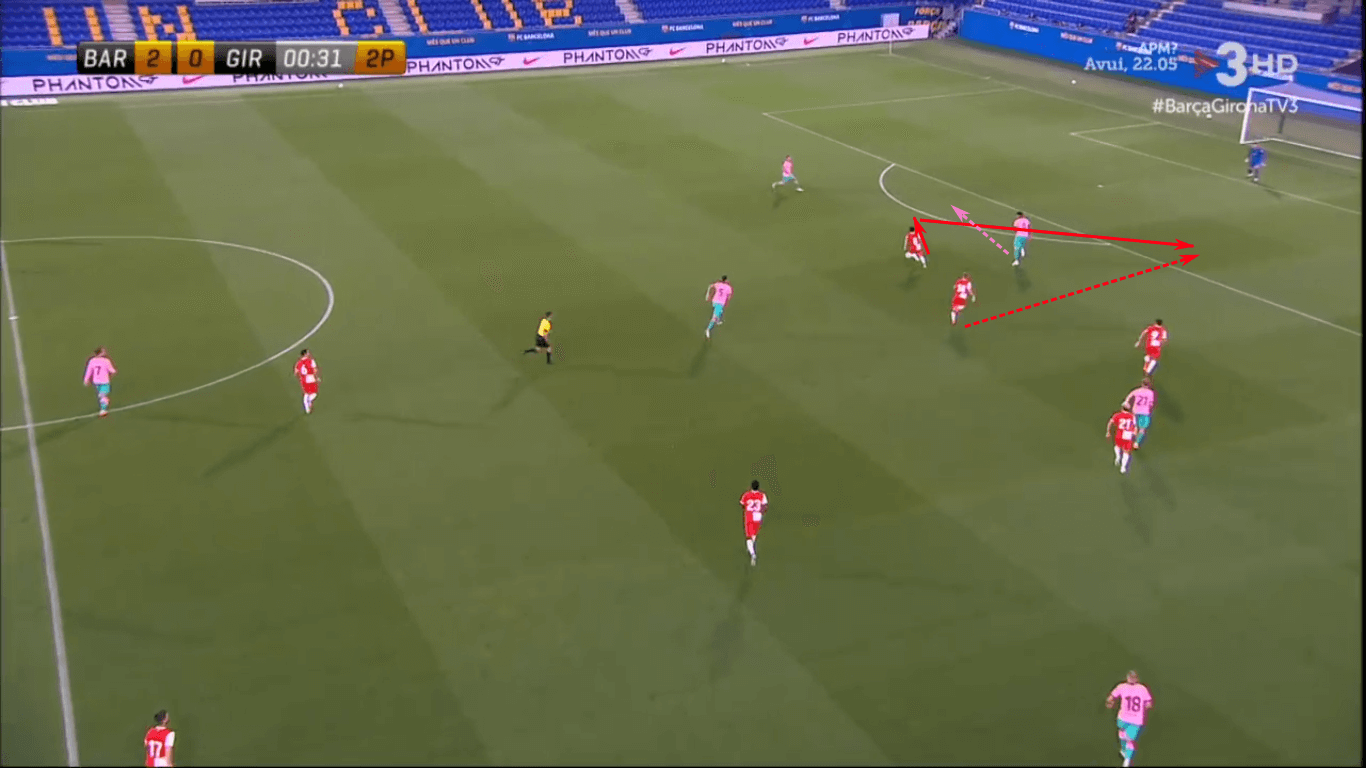
Counter-attacks starting near the middle third/attacking third border are certainly still areas of concern for Barcelona, but de Jong’s deep positioning should help. Discipline will be key for the young Dutchman, denying entry to Moreno, especially in transitional moments. Either way, expect Villarreal to be most dangerous when Barcelona becomes too expansive, especially in the build-up and when attempting to connect lines.
For Villarreal, safe and effective progression in the build-up will be key. In previous matches are any indication of how this one will turn out, Villarreal will have plenty of opportunities to play from the back. Look for Barcelona to engage in a high press, likely resulting in middle third recoveries.
To give you a sense of Villarreal’s defensive philosophy, expect them to engage in a conservative high press. Rather than a high-intensity, aggressive press, look for them to send one player to pressure while the others look to capitalize on poor body orientation and first touches.
In the image below, we see Villarreal engaging in a high press. With Casemiro maintaining a closed body orientation, his only reasonable passing option is Dani Carvajal. The play is well-read, resulting in a loft ball and turnover.
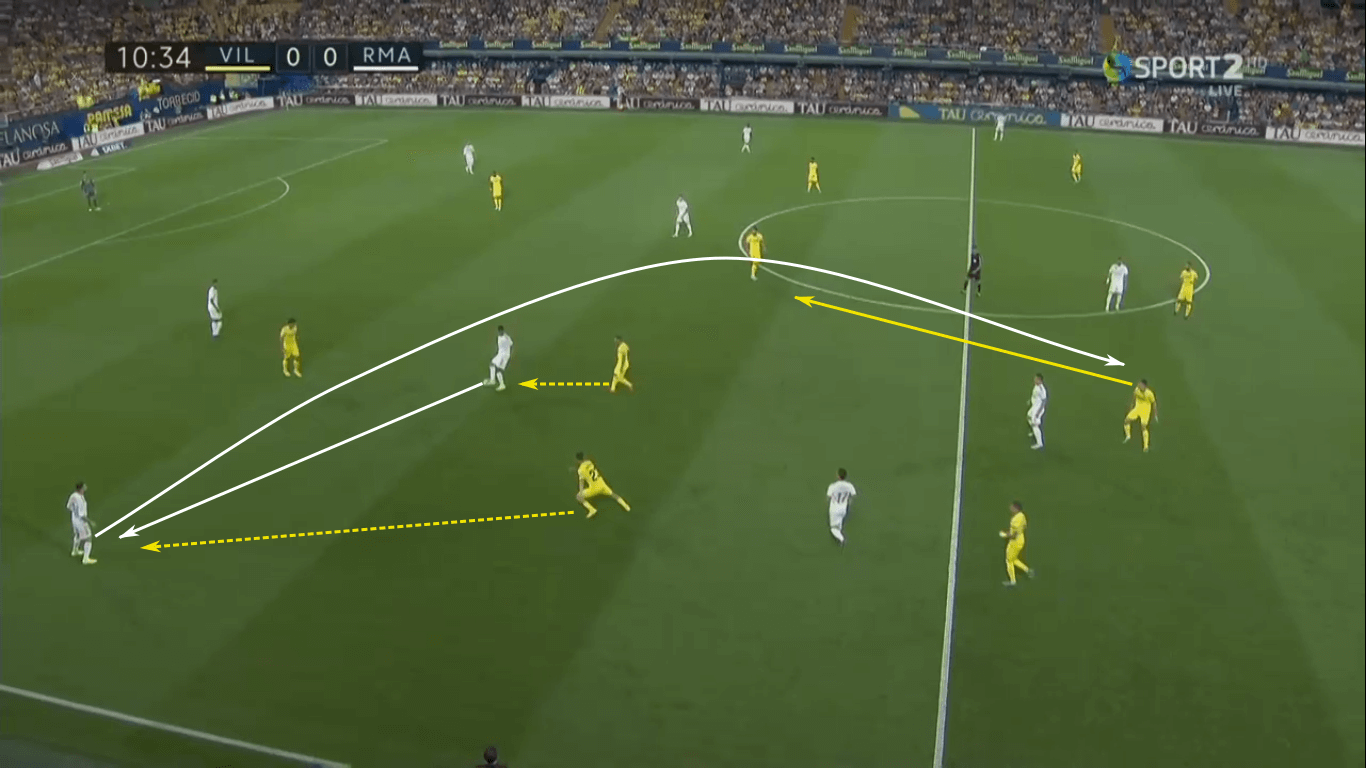
If Barcelona players can avoid these pressing traps, which is typically an area of strength, Villarreal could spend the game chasing Barca’s one and two-touch passes. Analysis of the previous match-up gives an idea of the cost of ineffectively high pressing Barcelona. When Villarreal engages, they must ensure the rest of the defensive structure is prepared to engage.
In preparation for penetration, look for Barcelona to test Villarreal’s vertical and horizontal compactness. With Barcelona likely to spend more time in the middle third, Villarreal’s structure is critical. Lining up in two banks of four with the two forwards funnelling play up top is expected.
However, as we see in the image below, Villarreal’s two lines of four does get stretched horizontally. For a side like Barcelona that looks to overload near the ball and create space to receive between the lines, this degree of width will only hurt Villarreal.
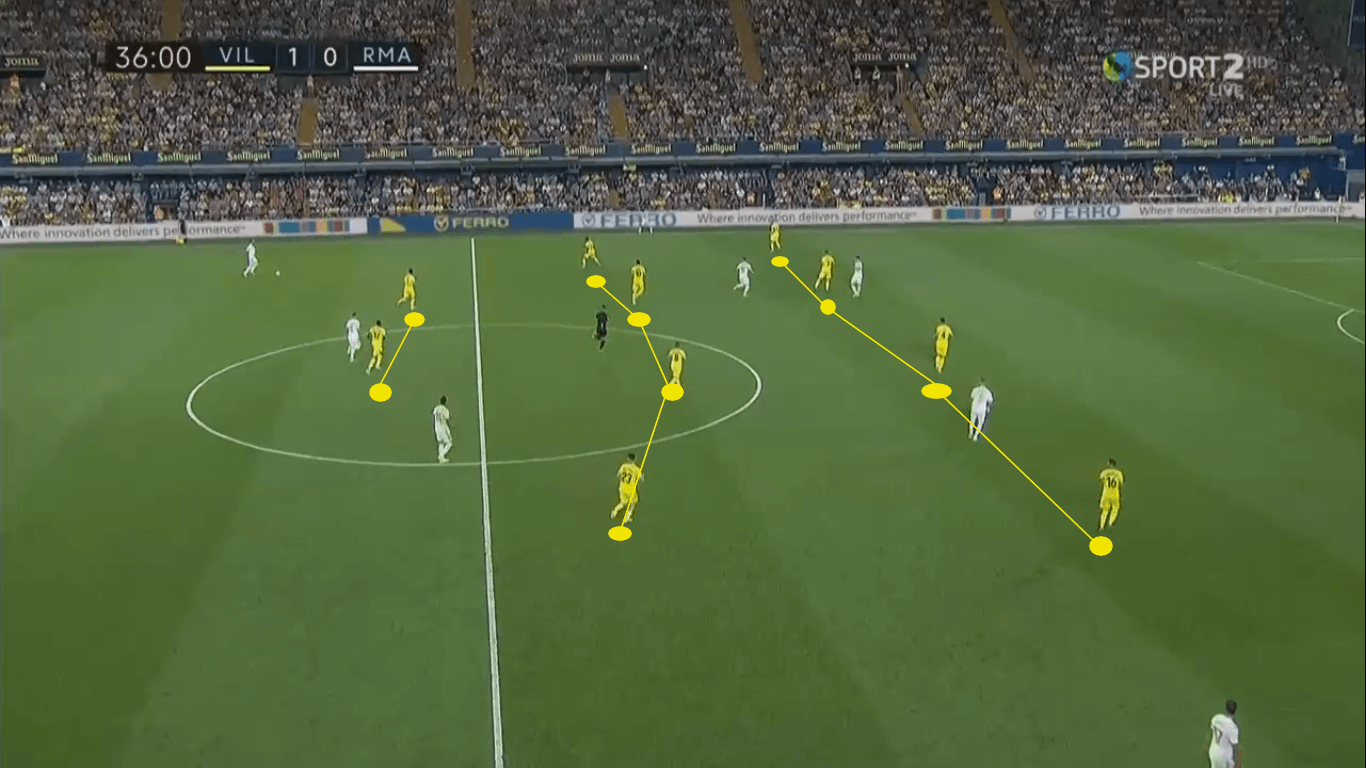
Ideally, funnelling Barcelona to the wings and defending in three out of the five vertical channels can keep Villarreal safe in the nearest channels. If Barcelona wants to play the long switch, Villarreal must prepare the outside-backs to start centrally and recognize the cues leading up to the switch.
Finally, in the defensive third, possession dominant teams can disrupt the Villarreal backline. With Barcelona’s possession and central overloads, they’ll have no shortage of runners into the box.
In the image below, Villarreal is defending with seven players behind the ball. As Karim Benzema has drops in line with the midfielders, gaps emerge in the Villarreal backline.
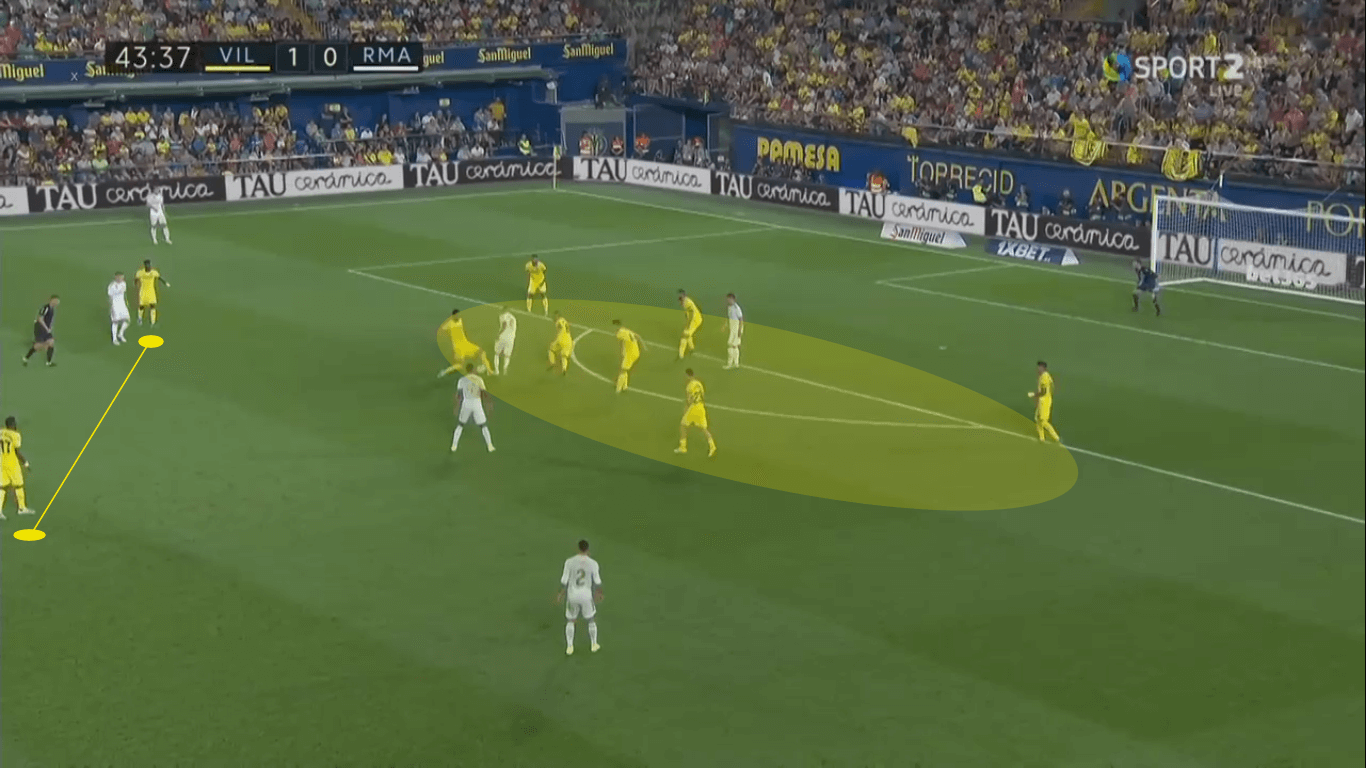
Villarreal must show awareness to neutralize the greatest threats and adapt the lines to deny running lanes through the central channel.
One other interesting note is the positioning of Chukwueze. Notice he’s positioned with Kroos. If Villarreal can defend effectively with Chukwueze starting near de Jong, watch out for the counterattack. He’ll have no one but Lenglet in front of him. Given the amount of ground Lenglet was asked to cover last season, his struggles to defend in open space offer a real opportunity for Villarreal, especially with Chukwueze’s pace.
Conclusion
Historically speaking, the numbers don’t favour Villarreal. In the 20 previous matches against Barcelona, they’ve managed just four draws and 16 defeats. It’s simply not a matchup that fits well with their playing philosophy. However, if there’s such a thing as catching an opponent at the right time, this is it. Additionally, Villarreal tends to keep a closer result in the first match of the season. With two matches in tow and a side that’s really been better than the two results would indicate, Villarreal will enter this one with a deep hope for victory.
Turning to Koeman’s Barcelona, the general consensus is that there are more questions than answers. Yes, Messi’s still there, but with the Argentine dropping deeper as his career progresses, who’s going to pick up the slack up top? More importantly, can this squad solve the attacking and defensive issues they dealt with last season?
Though there’s a good chance of a Villarreal result, I’m going to side with history and call a 3-1 Barcelona win.





Comments